|
Bomb Hits Enterprise. 24 August 1942
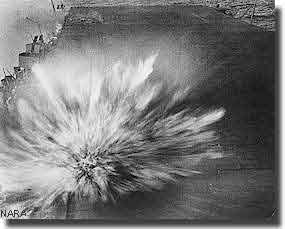 | Introduction.
After the disaster of the Battle of Savo Island, the beleagured US Marines were subjected to a daily bombing raid from Japanese aircraft emanating from Rabaul.
"Tojo Time" the Marines called it.
At night, Japanese cruisers and destroyers would steam down through "The Slot" to bombard the beachhead and Henderson Field, and withdraw before daylight dawned.
The only relief forthcoming, an occasional dash by destroyer transports into Iron Bottom Sound to bring in much needed fuel and supplies.
A type of status quo existed in this troubled area of the Pacific war at this time.
Importance of the Eastern Solomons to both the Allies and the Japanese cause.
Both Japan and the Allies needed the strategic positioning of Guadalcanal and Tulagi Islands.
If the Americans could maintain their toe hold here, their airbase would threaten Rabaul, on the other hand, Japan needed control over this Island chain if they were to cut the vital supply lines stretching from Hawaii through Samoa and Fiji and from the west coast of the United States mainland to Australia.
Australia was vital as a secure base on which to build up forces and supplies, to be used as the springboard from which the Allies could start to push back the Japanese advance.
The Japanese Navy controlled the seas north of Guadalcanal, but three US carriers, Enterprise, Saratoga and Wasp, waited to the south, anxiously prepared for the expected thrust of Japanese land forces to retake Guadalcanal and Tulagi Islands.
Japanese reaction to the US grab of Guadalcanal and Tulagi.
It did not take Japan long to react, the first assault coming on the night of the 14th. of August.
East of Henderson Field, 500 men from the Special Naval Landing Force came ashore, and on the following night, 1,000 more landed west of the Marines position.
The commanding officer, Colonel Kiyano Ichiki started to squeeze the Marines guarding this vital air strip still to be completed, from both ends.
Any Japanese success was but momentary, US patrols on the 19th. and 20th. at the Battle of Tenura River, routed the Japnese invaders.
Henderson Field ( so named after a Marine pilot killed at the Battle of Midway ) was completed, now US pilots could end the Japanese air supremacy over the Solomons.
More Japanese moves on Guadalcanal and Tulagi.
On the 20th. of August, 3,000 men had embarked at Rabaul, their destination Guadalcanal, from Truk, the Fleet carriers Shokaku and Zuikaku, ( both involved in the raid on Pearl Harbor ) moved southwards.
100 miles ahead, and covering the troop transports was the light carrier Ryujo.
Yamamoto's Operation KA, had two basic objectives, crush the American carriers that had eluded him at Midway, and support the landing of these 3,000 troops on their way from Rabaul.
US intelligence issued a warning on the 21st. of August, predicting a large Japanese force on its way to the south.
Admiral Chester Nimitz reacted quickly, he ordered Vice Admiral Ghormley to concentrate his forces in the vicinity of the Solomons, the stage was about to be set.
Ghormley acts.
On the 22nd. of August, Vice Admiral Frank Fletcher was ordered by Ghormley to take his three Task Forces, each with a carrier, north to take up the anticipated Japanese challenge.
Just before 1100 ( 11 AM ) an unidentified aircraft came up on Enterprise's radar screen, 55 miles SW of her, four Wildcats were sortied, and soon found a four engined, lumbering, Kawanishi flying boat, it was soon crashing into the sea in flames.
The Game hots up.
On the 23rd.as US ships patrolled just to the north of the Solomons, a patrol from Enterprise came across two Japanese submarines steaming southwards, probably ahead of the main force, they merely confirmed that a fight was in the offing.
Only a few hours later, Navy Catalinas found the Japanese troop convoy about half way between Rabaul and Guadalcanal.
Enterprise launched a strike force but it failed to locate the transports, they had turned north on being observed.
Now, US intelligence informed Fletcher on the afternoon of the 23rd. of August, that it seemed the main Japanese force was still at Truk, but was this information right or wrong?
Fletcher agonised about fuel levels in his ships, and now decided to detach Wasp, and her Task Force 18 to proceed south, to pick up the fleet tankers and replenish their fuel.
24th. of August 1942.
A wide arc of the Pacific Ocean north of Task Force 16 ( the Enterprise Group ) was scoured by 23 aircraft from "The big E" searching to a depth of 200 miles, but no enemy ships to be seen.
But at 1000 ( 10AM ) a Catalina reported a carrier, a cruiser and a destroyer 200 miles NW of the US force.
This was the light carrier Ryujo, with the cruiser Tone, scouting ahead of the main Japanese force covering the transports.
Now but 20 miles from the US force, another enemy flying boat was shot down, and an aircraft from Saratoga brought down a futher Japanese scout plane within visual distance of the Americans.
Now the Japanese Admiral was aware of the position of US ships, but in turn, Fletcher was only aware of the whereabouts of Ryujo and Tone.
But where are the main Japanese forces?
It had become urgent that the main Japanese strike force be located.
To this end, at 1300 ( 1 PM ) 23 fighters and dive bombers were launched from Enterprise to seek out and hopefully attack the enemy ships.
Fletcher was in a bind, 30 minutes had just elapsed, no enemy report from his despatched aircraft, does he launch a second group to attack Ryujo and Tone, the only known Japanese carrier within range, or does he wait until the main force is found?
He now ordered Saratoga to send off 30 dive bombers with 7 torpedo carrying planes to go get Ryuko, then, within minutes of this launch, Navy Catalinas and some of Enterprise's scout planes find them!
200 miles north of the Enterprise and Saratoga Task Forces, the two Japanese Fleet carriers Shokaku and Zuikaku are located, pressing on southwards at 30 knots.
With static filling the air waves, made worse by the undisciplined chattering between themselves of the US pilots, it took valuable time for this news to filter through to Fletcher. He now wanted his recently released strike aircraft to swap targets, and go for the main prize, the large carriers.
By the time his communications team contacted them, they were about to attack Ryuko, and by that evening she was sunk.
USS Enterprise in the Eastern Solomons Battle
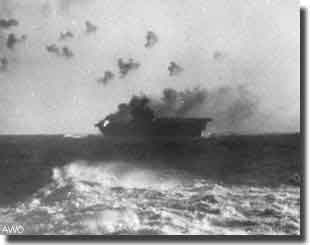 | Attack on Enterprise.
Fletcher was in Saratoga, at 48,500 tons full load, she had been launched in 1925, her keel originally that of a battle cruiser, and with a flight deck of 900 feet, her 83 aircraft could get off her deck in quick time.
Enterprise, commissioned in May of 1938, at 25,500 tons in her wartime role, she was smaller than Saratoga, her flight deck 809 feet long and her top speed equal to that of Fletcher's flagship at 33 knots.
Enterprise and Saratoga, as two independent Task Forces were proceeding 10 miles apart, every operational fighter waiting to take off to protect their respective ships.
At 1632 ( 4.32 PM ) the first signs of an impending attack, on the radar, distance 88 miles, bearing 320 degrees, a host of bogies ( naval talk for enemy or unidentified aircraft ) both carriers turned into the wind to launch their fighter protection.
Sailing close by Enterprise was the new battleship North Carolina, the cruisers Portland and Atlanta, and 6 destroyers.
Everyone would be straining their eyes for the first glimpse of enemy aircraft, from my own experience in the Pacific war, I know that this period of waiting for an attack that is on its way, this lull before the storm of an incoming air assault is the really tough time. Once you are under attack, you are generally engaged in performing your own task, you are too busy to be much concerned, it is during the waiting time when you get that knot in your guts, and thoughts such as "Will I survive?" come into your head.
Above the US Task Forces - 54 fighters, up there to protect all the "Fish Heads" ( or ordinary sailors to the fly boys )
Contact.
Contact came at 1655 ( 4.55 PM ) at 18,000 feet, well above the scrambling Wildcat Fighters straining to gain height and intercept, were two sections of Japanese Val dive bombers, protected by the superior Zero fighters.
Over 20 minutes, a free for all dog fight took place, Wildcats, Vals, and Zeros all tangling together, Enterprise pilots later claimed 29 Japanese aircraft disposed of.
Launch of last Dive Bombers and Torpedo planes from Enterprise.
Whilst this battle raged over the Enterprise Task Force, the last 11 Dauntless bombers, and 6 Torpedo carrying aircraft were launched.
This decision to launch was well made, these planes had sat, readied on the flight deck, within minutes of them being airborne, a torrid attack by Vals was under way. Fire from the 5 inch batteries, mingled with the 20mm close range barrage, North Carolina and the two cruisers adding their considerable AA fire to the melee.
Down came the Vals in their first steep dive, one every few seconds, after releasing their bomb, they would fly close to the deck, trying to get away.
For two minutes the Big E weaved with great dexterity, her AA armament claiming 15 attackers, but the sheer weight of numbers of the attack overcame the defence, ( During Kamikaze attacks in Luzon, in the Philippines in January of 1945, I was staggered that attacking aircraft could survive the sheer wall of metal thrown skywards by the Fleet, and still come through to crash into a Fleet unit. )
The first bomb hit the flight deck of Enterprise, penetrated through five decks before exploding. It was precisely1714 ( 5.14 PM ) and it claimed 35 personnel, and the blast ripped open 6 foot wide holes at the waterline, the ship began to list to starboard.
The blast bulged the hangar deck upwards some two feet, and put the aft aircraft lift out of action.
The second bomb.
Within half a minute, a second bomb struck, only 15 feet from where the first bomb had penetrated the deck, a further 38 men died, 10 of whom were never identified, so fierce was this detonation.
Enterprise with smoke pouring from her wounds was still able to press on at 27 knots. Below decks and on the flight deck crews fought desperately to control the subsequent fires, restore power and rescue survivors.
Third Bomb.
For 90 seconds the Task Force gunnery kept the invaders at bay, but now, only 2 minutes from the first bomb arriving, a third smacked into the flight deck, a ten foot hole resulted and No 2 lift disabled, more sailors died.
Attack over.
For now, the attack was over, and Enterprise listing, on fire, could still make 24 knots.
But, she still needed to recover her returning aircraft, working at a feverish pace, Damage Control crews took charge of the fires, patched the hole in the flight deck from bomb Number 3, counter flooded to correct the list, and stuffed the waterline holes with mattresses, backed up by timber shoring. With evening fast approaching, the Enterprise was able to recover her aircraft, a minor miracle in itself.
Launch of second Japanese strike.
The Japanese Commander, Chuichi Nagumo assumed the sacrifice of Ryujo had occupied the American aircraft attack, he launched a second strike to seek out the US ships.
Just as the Task Force picked them up on their search radar, Enterprise suddenly lost control of her steering, she swung right - left - right again, and at 1850 ( 6.50 PM ) the steering gear jammed hard over.
Desperate Times.
Radar showed an incoming attack but 50 miles away, Enterprise only just missed chopping the US destroyer USS Balch in half, meantime the big carrier was going around in circles, and not even going ahead on her starboard propellors, and astern on her port ones could pull her out of this deadly circling routine. It took 38 minutes of frantic work to fix the steering motor problem, but the luck of Enterprise held, the Japanese squadrons passed safely 50 miles to the south of the Task force, they reversed course to the north west, but did not sight the US ships.
Night fell, and Enterprise suprisingly survived, to fight further battles in the Pacific war.
The Battle ledger.
Although Enterprise was severely damaged, she lived, an American victory in this Battle of the Eastern Solomons could be claimed on two counts, strategically and tactically.
Operation KA planned by Yamamoto had caused the sinking of Ryujo, the Japanese lost 71 planes from Shokaku and Zuikaka, and over 100 experiences pilots were killed, these of course irreplaceable, on the US side, 20 aircraft lost from their two carriers, and in Enterprise, 74 died with another 91 wounded.
The Aftermath.
Yamamato cancelled Operation KA, his first attempt to regain Guadalcanal, a total failure.
In deciding to send Wasp to refuel, Fletcher had effectively removed one carrier from the area, her presence at the time of the attack may have helped to save the Enterprise, or her aircraft on additional patrols may have located the Japanese force, but it is easy to speculate on what might have been. So many times in war time, and generally in one's life, WHAT IF is asked, but all to no avail!
After the Eastern Solomons, late August, and into September.
Late in August, the Japanese attempted to run 3,500 troops into Guadalcanal, and on the 28th. the Cactus Air Force Dive bombers attacked them, sinking the Destroyer Asagiri, and the landing was called off, with the ships returning to Rabaul.
But the next day, 450 soldiers came ashore from the Destroyer Yudachi, and supporting Japanese bombers sank the US Transport Colhoun trying to top up US supplies.
The Japanese were making nightly runs down "The Slot" with extra troops.
On the 26th. of August and east of San Cristobel, Fletcher's TF 11 with Saratoga, met up with Rear Admiral Noye's TF 18 which included the carrier Wasp.
Whilst Rear Admiral Kinkaid's third TF 16, sheltering the damaged Enterprise made for the New Caledonia area.
At Tongatabu, the damage to Enterprise was assessed, with an escort of the cruisers Portland and San Juan plus 4 destroyers, and a tanker she set out for Pearl Harbor on the 3rd. of September. At Pearl, repair crews slaved 24 hours a day to get her back into service.
Rear Admiral Murray's TF 17, with Hornet joined up with Fletcher and Noyes on the 29th. August, thereby giving Fletcher three carriers at his disposal once more. This TF included the heavy cruisers Northampton and Pensacola, the light AA cruiser San Diego, and 6 destroyers.
After TF 17 joined up, Fletcher moved south towards Espititu Santo, he would advance his force north by night, and run back south during daylight hours.
All up, his three carriers had 215 operational aircraft, and on the 30th. of August, TF 18, which included Wasp, was ordered back to Noumea to reprovision, it was June since she last stored ship, and this lengthy time won her the right for a break.
Early on the last day of August, Saratoga picked up a torpedo on her starboard side from the Japanese submarine I-26, injuring 12 including Vice Admiral Fletcher.
Minneapolis passed a tow line to the stricken carrier, and with two engines she made good 10 knots, and was able to launch aircraft, this feat whilst under tow, was described as a "Unique performance."
The Saratoga now sailed for Pearl Harbor to undertake repairs, arriving there on the 21st. of September.
Vice Admiral Frank Fletcher relieved.
Fletcher was relieved of his sea command, and took up a shore job at Seattle, then in 1943, he was given the North Pacific area, he did not command at sea again.
Lunstrom in his book: "The First Team and the Guadalcanal Campaign," comments on Vice Admiral Jack Fletcher: "History has come down hard against Frank Jack Fletcher's competence as a carrier leader, but once his decisions are studied in the light of what he himself knew at the time, a different picture emerges."
But personally, I don't know about that, Fletcher lost Lexington at Coral Sea, and Yorktown at Midway.
As the Expeditionary Commander for the assault on Guadalcanal in August 1942, he had promised to keep his carriers in the area for three days, but withdrew them after only two days, leaving Turner with little alternative but to withdraw all surface forces, leaving Vanderfrift and his Marines high and dry on a hostile shore at Tulagi and Guadalcanal.
Now he is in Saratoga, and she is torpedoed.
I still belong to the school, that judges Vice Admiral Jack Fletcher harshly for his performance as a carrier commander.
By the 8th. of September, TF 18 had completed their stay at Noumea, and Noyes headed NE for Espiritru Santo, they escorted Turner's flagship McCawley, and he shared his plan to bring the 7th. Marines to Guadalcanal.
Turner asked Noyes:
( a ) to provide extra aircraft from his carrier for Cactus, ( this was the code name for Guadalcanal and Henderson Field )
( b ) maintain a constant anti-submarine patrol off Malaita - San Cristobel, and
( c ) attack any Japanese naval force threatening his convoy.
Noyes was non plussed by requests a and b, and quickly told Turner they were impossible, he had no spare fighters to send off to Cactus, he could not tie up his carrier in one area just to fly anti-submarine patrols to please him, now Turner put Noyes in the same poor light box, where he placed Fletcher earlier after his desertion after Savo.
Amphibian Tractors going ashore at Guadalcanal August 1942
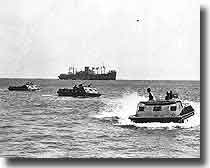 | On the 9th. of September, Ghormley issued his basic organisation plan.
TF 61, Noyes with all the carriers, TF 62, all Amphibious Forces under Turner, TF 63, Air South Pacific under McCain, and a new group, TF 64, the South Pacific Screening and Attack Force under Rear Admiral Wright.
Landing US troops at Guadalcanal, Japanese destroyers bombard at the same time.
On the 4th.of September, US destroyer transports Little and Gregory were landing both troops and supplies at night, at the same time, Japanese destroyers Yudachi, Hatsuyuki, and Murakumo were carrying out a bombardment.
A Catalina flying boat saw their gun flashes and assumed they were coming from a submarine, dropped flares which illuminated the US ships for the Japanese just as if they were a christmas tree, and they were blown to pieces.
Reinforcements for Guadalcanal.
Earlier we learned that Turner had shared with Noyes his plan to land the 7th. Marine Regiment, they were now in 6 transports escorted by Wright's TF 64, and covered by Hornet and Wasp with their associate escorts.
Air searches had been flown to see if there was any threat from a Japanese naval force, but at this stage nothing was uncovered.
It was intended to be a two day trip from Espiritu Santo to Lunga at Guadalcanal, and a start was made on the 14th. of September.
On the other hand, a Mavis ( nick name for a Japanese Kawanishi flying boat ) out of Rabaul, sighted a US carrier 123 degrees 345 miles from Tulagi.
Noyes was operating about 100 miles NE of the transports to shield them from any approaching enemy force.
At 1035 ( 10.35 AM ) Noyes was advised by a Catalina that he had sighted 4 Battleships, and 7 Carriers on a course 140 degrees at 17 knots 325 miles NW of him. ( there is no way the Japanese had 7 carriers operating here, and I am sure Noyes would have had the same thoughts, but, ship recognition and reports from Allied air crews were so often very badly wrong. )
Shortly afterwards, this Catalina amended his report to now read: 3 Battleships, 4 Cruisers, 4 Destroyers and 1 Transport.
Now another Catalina reported a second group, 200 miles north of the first report, this was Vice Admiral Nagumo's Strike Force of 1 Carrier, 3 Cruisers and 4 Destroyers.
Six Zero's quickly located and destroyed this Cat.
Noyes despatched a scout group to seek out targets for Hornet's aircraft.
By 1415 ( 2.15 PM ) having failed to find any US carriers, Vice Admiral Kondo's Support Force altered course to 005 degrees and retired, the probing aircraft from Wasp missed them. By 1630 ( 4.30 PM ) both US carriers had recovered their aircraft, a stalemate for both US and Japanese forces.
The 15th. of September dawned to present a quiet scene, but by 1105 ( 11.05 AM ) a Bogey had come up on Hornet's radar, and a Combat Air Patrol from Wasp shot down a Mavis that had flown from the Shortlands, no one could be sure if TF 61 had been sighted, and reported, before the Mavis had been disposed of.
Wasp worked her aircraft to support Turner, and at 1345 ( 1.45 PM ) having just completed flight operations torpedoes were sighted making for her starboard bow.
Noyes had unknowingly crossed a line of Japanese submarines strung out from the north east to the south west.
I-19 was in a great position to let go with a 6 torpedo spread, another submarine I-26 also sighted the TF, but was too far away to fire.
One torpedo slammed into the starboard bow of Wasp, a second struck the hull, opening gas tanks and flooding bomb magazines.
Wasp was in mortal danger, and immediately took up an 11 degree list to starboard. 8 black mess attendants, cooks and stewards died from the second fish.
Counter flooding reduced the list to 4 degrees, but at 1405 ( 2.05 PM ) another huge explosion rent the Wasp, just ahead of the island, the bridge was shattered with Rear Admiral Noyes suffering burns, and Captain Sherman lucky to survive.
The decision was made to abandon ship over the stern, torpedoes that missed Wasp, continued to run to the north east, and one slammed into the US Destroyer O'Brien, which sank later. ( My surname is Gregory, my wife's maiden name was O'Brien, both ships carrying our names had been sunk.)
Another torpedo picked up the bow of the battleship North Carolina, flooding magazines and killing 5 crewmen, one spread of 6 torpedoes had gained a fair result for the Captain of I-19.
USS Wasp and destroyer USS O'Brien both caught in same photograph, both victims of Japanese Torpedoes
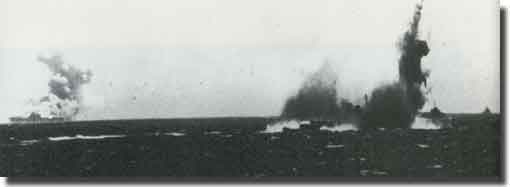 |
Rear Admiral Scott sent across Ward and Duncan to join the cruisers San Francisco, Salt Lake City, and Helena to steam around Wasp, whilst Juneau, Farenholt, and the destroyers Lansdowne, Laffey and Lardner all collected survivors.
The now abandoned Wasp still hung on, she had a 15 degree list and was blazing away, Lansdowne was ordered to sink her, 5 torpedoes were fired, one at a time, 3 hit, but Wasp was stubborn and did not want to go, finally at 2000 ( 8PM ) she went down by the bow.
Of her crew and passengers, 194 died, and 46 planes were lost.
Whilst the problems with Wasp were going on, Turner loitered, then on the 16th. he decided to press on, now due at Lunga point on the 18th.
Turner and his transports did arrive on the 18th. and all the Marines quickly disembarked.
Hornet now on her own.
As Turner reinforced Guadalcanal, Hornet was now the sole carrier in the South Pacific, and she stayed close to Espiritu Santo, and Ghormley told Murray to stay clear of Torpedo Junction.
Until Enterprise could be repaired and return, any air strike force in the area was very much weakened.
Nimitz sends auxiliary carrier.
Admiral Nimitz at Pearl Harbor was greatly concerned by the loss of Wasp, and the paucity of carriers in Ghormley’s command.
He offered him the newly commissioned auxiliary carrier Copahee, as a combatant carrier, to be manned by Wasp and other stranded carrier personnel.
This ship was the first of the Bogue class of carrier, 494 feet long with a speed of just 18 knots, but Ghormley declined to use Copahee in a combat role, but said he could use her in a ferrying capacity, but if three such ships were available he could use them in an effective combat role.
However, not even Nimitz could pull out three Bogue carriers from his bag of tricks.
Noyes now became the scapegoat for the loss of Wasp, and was exiled as a result to a shore job with the Board of Inspection and Survey, quite a come down!
End of September and Japanese reinforce Guadalcanal.
The seaplane tender Nisshin, loaded with troops and weapons, and supported by a strong air presence was scheduled to reach Guadalcanal on the 30th. of September.
But bad weather closed down Japanese air operations and Nisshin’s run was postponed until the 8th. of October.
Nimitz visits Guadalcanal.
Admiral Nimitz decided to visit Guadalcanal to see if it could be held against the strong Japanese resistance, and their ability to continue to run in reinforcements.
He arrived on the last day in September and toured the area, investing fliers with Navy and Distinguished Flying Crosses.
He discussed the local situation with Vandergrift, finding only optimism on Cactus, then flew out the next morning to Espiritu Santo, deciding that the US Marines looked as if they could hold fast.
Give and take around Guadalcanal - October 1942.
Introduction.
Come October, the Japanese were still using the Tokyo Express to run into Guadalcanal, both troops and supplies. Their air support had been slowly whittled away by constant pressure from the Cactus Airforce.
Nisshin and 5 Destroyers leave Shortlands.
More troops, supplies, and heavy weapons were loaded aboard the large seaplane tender Nisshin, supported by 5 destroyers, and they sailed from the Shortlands on the 8th. of October.
Heavy rain precluded a planned figher sweep of 27 Zeros guided by 9 land attack aircraft.
US Air Strike force.
On the 9th. of October, an air strike force was sent out against 5 Japanese destroyers retreating 180 miles up The Slot, came across the Nisshin force on its way down.
A second strike force, was now despatched to find and attack the seaplane tender, surrounded by her 5 destroyers in a reverse horseshoe formation, the advancing area being open. But, by 1800 ( 6 PM ) the sun was setting, and the high Japanese Combat Air Patrol spotted the incoming US force of 7 carrier bombers, 4 torpedo bombers, and their 9 Grumman fighter escort.
The dive bombers and torpedo aircraft made their runs, one bomber claimed one hit and several near misses, the Avengers let go their fish, but no hits were registered.
In the ensuing melee, 3 seaplanes were claimed destroyed, and one F4F ditched.
Activity at Guadalcanal.
Each morning Henderson Field could expect a sweep to be made over them, usually by 27 Zeros.
Cactus had the auxiliary carrier Copahee bring in a further welcome 20 F4F aircraft, whilst the Japanese light cruiser Tatsuta, managed to sneak in Lieutenant General Hyakutake Harukoshi to Guadalcanal on the evening of the 9th. of October.
Guadalcanal in mortal peril.
The Japanese decided to make a combined land, sea, and air offensive to gain control of the air field on Guadalcanal.
The Japanese Base Airforce had been built up, and two daily strikes against Henderson Airfield could now be achieved. On the 11th. of October, both big seaplane tenders Nisshin and Chitose, filled with fresh troops, supplies and equipment, escorted by 6 destroyers were sailed from the Shortlands.
To soften up the Guadalcanal defences, Rear Admiral Goto Aritomo's Support Force of 3 heavy cruisers and 2 destroyers would bombard the airfield after midnight on the 12th. of October.
A high speed convoy of 6 army transports were to land troops/supplies on the 18th. of October, meanwhile on the 11th. a large segment of the Combined Fleet left Truk to add support to this push, including Vice Admiral Kondo's Advance Force ( 2nd.Fleet ), with the carriers Hijo and Junyo, and Vice Admiral Nagumo's Striking Force ( 3rd. Fleet ) that was built around the carriers Shokaku, Zuikaku and Zuiho.
All that stood in their path was the 1st. Marine Air Wing, and Vandergrift had learned that Rear Admiral Scott's 2 heavy cruisers, 2 light cruisers and 5 destroyers would operate north of Rennell Island to tackle the next attempt to push out the US Marines from Guadalcanal.
Rear Admiral Willis Lee's flagship USS Washington
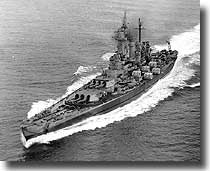 | Rear Admiral Murray's TF 17, with Hornet, was south of Guadalcanal in a support role, and Rear Admiral Lee with the new battleship Washington, an AA cruiser, plus 2 destroyers would try to protect the next run made by Turner's 7 ships carrying the Army's 164th. Infantry Regiment.
The odds of US forces hanging on to their toehold here in the Solomon Islands were not good.
Air Strikes.
On the 11th. of October, the Japanese sent off two airstrikes within an hour of each other, hoping to catch the US fighters unprepared.
16 Zero aircraft made up the first strike, and only another 45 minutes later, 45 land based attack planes, escorted by 29 Zero's swept in, 90 enemy planes all up, attacking Guadalcanal.
For once, these planes were not sighted by the string of Coast Watchers, then at 1224 ( 12.24 PM ) two flights were picked up by radar, 138 miles north west, 51 fighters were scrambled to take them on. 8 F4F's tangled with the first wave, but all 16 Zero's made it back to their base.
The second wave arrived, but now clouds covered the airfield, offering some protection, and most enemy aircraft turned back without attacking.
These two raids cost the defence 2 aircraft, whilst in the general confusion, the Cactus fighters claimed 11 bombers and 4 Zero's.
This first double raid, without a doubt, failed.
Nisshin and Chitose and their destroyers arrived about 2245 ( 10.45 PM ) and landed their cargoes on the north shore.
Enter Halsey.
For some time Admiral Nimitz had been concerned whether Vice Admiral Ghormley was the ideal man to be in charge of the South West Pacific Area.
He needed an aggressive commander to inspire the US fighting men, and Guadalcanal was vital in the scheme of things, it just had to be held.
On the 15th. of October 1942 he had come to a decision, and proposed to Admiral King that Vice Admiral Bull Halsey was the man he wanted, and Ghormley had to go. He gained approval from King for this change, and Halsey immediately took over.
Two of the major players in the debacle of Savo Island, Fletcher and now Ghormley had now been replaced, with neither to have a sea command again.
Map of the Battle of Eastern Solomons
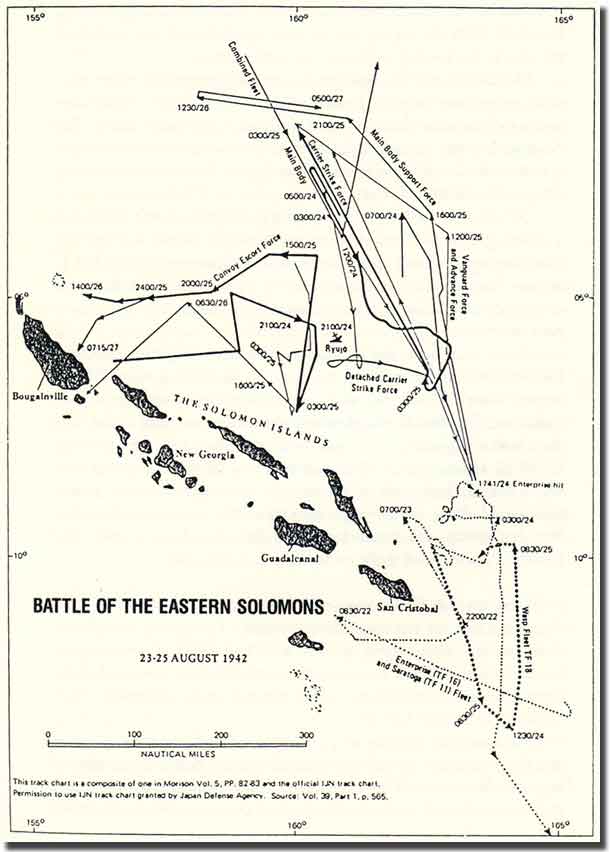 |
|